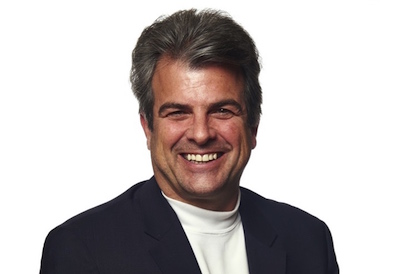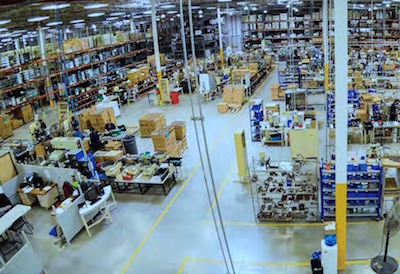Éric Deschênes, Executive Vice President, ABB Electrification Business

May 16, 2019
By Line Goyette
Difficult to deflect Éric Deschênes from his passion: understand to find solutions. Understand the technology, of course, but also the social implications of technology and business models that can maximize the adoption of these technologies. It’s what led him to study engineering and has set the direction of his professional career for 26 years.
“I studied mechanical engineering because what interests me is the structured approach to finding the solution to a problem.” He also developed, through his participation on many boards of directors, a more human side by giving back to his community, which has helped him see the social aspects of technology. His professional life is also driven by the development of new business models.
After graduating in mechanical engineering from the École Polytechnique, Éric’s first job was at Emerson Electric as an applications engineer. He worked in several market segments: wood, food, petrochemical, mining, pharmaceutical. He progressed rapidly and at 32 was leading a sales and applications team in the telecommunications segment. In 2003 he was recruited by Schneider Electric, where he developed his knowledge of automation, industrial controls and power distribution, and won success in sales, marketing, engineering and strategic acquisitions. In 2010, he was entrusted with the direction of the energy division, and in 2014, added the division of strategic segments and end users to his portfolio. In 2017, he was appointed North American Vice President, Mining Metals & Minerals, and led a North American sales team (Canada, United States and Mexico). He was recruited by ABB Canada at the end of 2017 and commented as follows: “I had the opportunity and the privilege to succeed John Sencich.”
Why this new challenge? Three reasons motivated his choice:
• the exceptional credibility of the sales force of Thomas & Betts (ABB)
• the acquisition of GEiS by ABB — the fifth or sixth acquisition of his career, which gives him an incredible opportunity to use his engineering knowledge and experience to reinvent the business model
• the ability to work with a recognized leader, Nathalie Pilon
Éric continues, inexhaustible, “ABB is a business model centred on the needs of the customer. The process of collaboration and transparency put in place allows us to talk not just about products, but about an architecture that goes from the substation to the electrical outlet at home.”
Eric is responsible for ABB’s Canadian Electrification Products Division. His new challenges? “In our business, we offer solutions to customers that they don’t yet know they need. The arrival an ABB-Hitachi (joint venture) power grid partnership will allow us to accelerate the digitalization of the public grid. We can speak of a ‘smarter grid’ that will become more digitized, more decentralized, and decarbonized. It’s a win-win-win solution for everyone.”
The situation is unique to Canada. “Here we have public electricity supply companies, and their business model will necessarily have to evolve and change.” He goes on to explain, “The most complex system in the world developed by human beings is the electric grid. This system was developed to respond frequently to two peak periods of service daily and annually. In addition, energy efficiency must be on the agenda because for every three units of energy produced one is consumed and the other two ‘vaporize.’
“With the social transformations in front of us — among other things the increase in the number of data centres, adoption of electric vehicles, renewable energy, storage systems, and the arrival of microgrids — there is no doubt the public sector faces many new challenges in supporting these new players in the energy sector. It is likely that the current pricing model will have to change in order to adapt to this new reality.”
We see emerging here the development of new business models. “We are now able to help the electric grid to reinvent itself. This is good news for us all, from the point of view of end customers.”
An advantage to advancing this digitalization and architecture based on customers’ needs? “The acquisition of T&B by ABB helped us to understand the Canadian business model, including distributors. In Canada, our industry has about 880 distribution outlets and we serve about 650 of them. This T&B legacy is an asset for ABB. We are one of the only major manufacturers to have a distribution centre, here in Bromont (285,000 square feet), which allows us to provide excellent value to our partners and customers while remaining competitive. Our distribution centre has a 99.96% level of effectiveness, and when combined with our ‘Signature Services’ program the management of our distribution network is harmonious thanks to a unique partnership culture.”
Éric continues, “The acquisition of GEiS has enabled us to complete our offer of products and electrical distribution equipment of ANSI-NEMA standards. This acquisition now allows us to offer the most complete range of electrical distribution products and equipment in Canada. ABB is facing a unique and unparalleled business opportunity. Indeed, we can either reinforce the current business model, including a single manufacturer in electrical distribution by distributor, or change this business model and allow distributors to have more than one major line offered in a distribution network of electrical products. Regardless of the business model, this will continue to provide healthy and honest competition with a unique value offer for our customers and partners.”
He explains the added value this way: “The strategy we put in place can be explained in three parts: standard products, CTO (configure to order) electrical distribution equipment, and ETO (engineer to order) electrical distribution equipment. For standard electrical distribution products, we build on T&B’s legacy by offering added value — ‘one order, one shipment and one invoice’ — directly from our Bromont distribution centre. We also put in place the CTO electrical distribution equipment component, the first flagship product for which will be the lighting panel, which will be assembled in Montreal with Canadian steel. For the third part, ETO electrical distribution equipment for low and medium voltage products and motor control centres, we are evaluating the necessary structure as well as the supply chain required to set up and have it in pilot mode from 2020.”
Éric’s impatience to succeed in the implementation of the new business model and the new technological era is palpable. “People need to be asked to understand the role they have to play in accepting technology. We are talking about global warming and we are saying that imminent changes are essential in the generation, distribution and consumption of energy. We need to optimize everything around us, starting with the switch. AC power has won the battle, but in the near future we could have a DC bus at home. In addition, the Internet of Things will allow us, with intelligent products, to control the electric charge and thus optimize energy consumption at any time. We are in the 3D energy age: Decarbonize, Decentralize and Digitize energy. The technology is ready, it must be accepted and made available, and we must put in place the necessary business models to allow our public electrical grid to modulate and optimize in real time our demand for energy.” And Éric Deschênes will be at the front lines of these changes.
Line Goyette is Managing Editor of CEW; linegoyette@kerrwil.com.











